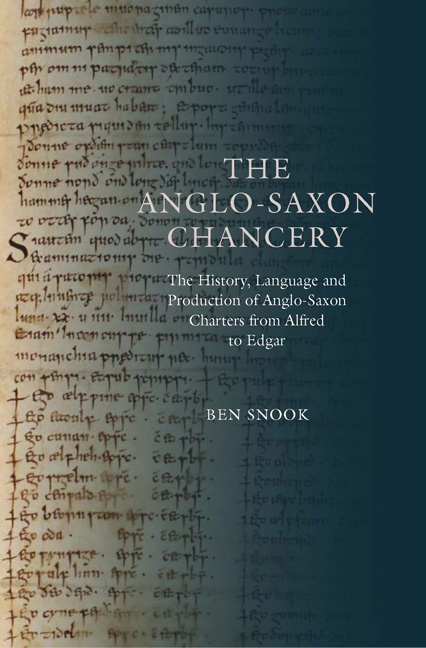 The Anglo-Saxon Chancery
The Anglo-Saxon Chancery Book contents
- Frontmatter
- Epigraph
- Contents
- Acknowledgements
- list of Abbreviations
- Timeline of Key Events between the Accession of Alfred and the Death of Edgar
- Introduction
- 1 Brave New World: The Charters of Alfred and Edward
- 2 Æthelstan
- 3 ‘Æthelstan A’
- 4 Turbulent Priests: Dunstan, Cenwald and Oda
- 5 Back to the Future: Edgar and ‘Edgar A’
- Conclusion
- Appendix I S 193
- Appendix II S 346
- Appendix III S 225
- Bibliography
- Index of charters
- Index
4 - Turbulent Priests: Dunstan, Cenwald and Oda
Published online by Cambridge University Press: 05 May 2015
- Frontmatter
- Epigraph
- Contents
- Acknowledgements
- list of Abbreviations
- Timeline of Key Events between the Accession of Alfred and the Death of Edgar
- Introduction
- 1 Brave New World: The Charters of Alfred and Edward
- 2 Æthelstan
- 3 ‘Æthelstan A’
- 4 Turbulent Priests: Dunstan, Cenwald and Oda
- 5 Back to the Future: Edgar and ‘Edgar A’
- Conclusion
- Appendix I S 193
- Appendix II S 346
- Appendix III S 225
- Bibliography
- Index of charters
- Index
Summary
The two decades between the death of Æthelstan in October 939 and the accession of edgar to a reunited kingdom in the summer of 959 are amongst the most fascinating of the whole Anglo-Saxon age. There are differing interpretations of the reigns of Edmund, eadred and eadwig. on the one hand, their time in power was wracked by political instability, factionalism at the court, and moral impropriety: Edmund, having lost York to the Vikings, was murdered at Pucklechurch in Gloucestershire in 946 by a disenchanted exile; his sickly brother, eadred, who succeeded him, relied on a kitchen cabinet to run the country on his behalf and seems never to have exercised much direct authority; and eadwig, eadred's nephew, was unreliable, impious and unpopular. having slipped away from his coronation feast to enjoy a ménage à trois with his future wife, Ælfgifu and (somewhat improbably) her mother, Eadwig was interrupted in flagrante by an enraged Dunstan, then abbot of glastonbury, who marched the no-doubt-disgruntled king back to the feast, demanding that he fulfil his royal duties in a more propitious manner. It was an ominous start to a reign which ended with the temporary division of the kingdom following a virtual coup d’état by the northumbrian and Mercian nobility in favour of Eadwig's brother, Edgar.
On the other hand, Edmund actually enjoyed significant military success against unfavourable odds in the north and, by the time of his death, had retaken a respectable portion of the territory he had lost, receiving the submission of several Scandinavian warlords in the process. He maintained England's high profile abroad, restored the house at glastonbury and issued a law code. likewise, eadred brought much of northumbria back under royal control, receiving the outright submission of its independently minded nobility in 954, and oversaw the refoundation of the house at Abingdon which would go on to become a major Anglo-Saxon cultural hub.
- Type
- Chapter
- Information
- The Anglo-Saxon ChanceryThe History, Language and Production of Anglo-Saxon Charters from Alfred to Edgar, pp. 125 - 158Publisher: Boydell & BrewerPrint publication year: 2015
